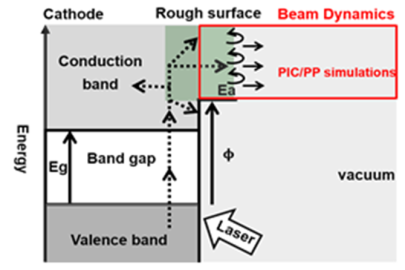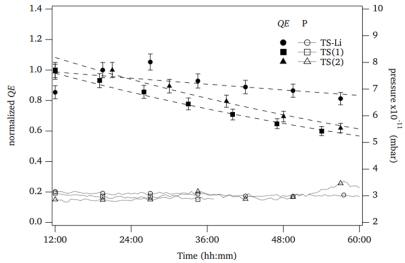At the Darmstadt cathode teststand “Photo-CATCH” a continuous effort to install a cryogenic DC photo-gun is underway as a part of a matching project to the RTG’s first funding period. The project is currently aimed at quantifying the enhancement of vacuum lifetimes due to cryogenic pumping of residual gases close to the cathode NEA surface. However, once completed, the cryogenic source may provide additional insight into the dynamics of the electron emission process with semiconductor photocathodes and their dependence on temperature.
With bulk GaAs cathodes, pioneering studies have been performed by the Heidelberg group about 15 years ago. They have shown that electron properties change when emitted from a cold cathode as compared to room temperature. However, below 90 K no detailed information exists on the interplay between energy spread of the emitted beam, quantum efficiency, and beam parameters. Similarly, the Cornell group has developed a cryogenically cooled Cs3Sb photogun, operated at LN2 temperatures. Here, Photo-CATCH could reach lower temperatures, too, and extend the results on the lowered transverse emittance (again, at reduced quantum efficiency) towards even lower temperatures.
Betreuer/in: Prof. Dr. Joachim Enders
Results achieved at the MESA injector with the source STEAM (Small Thermalized Electron-source At Mainz) set the stage for more ambitious beam parameters. STEAM has been operated reliably using the extremely demanding negative electron affinity GaAs-photocathode with a potential of 100kV and an extraction field of 2.5 MV/m. This already exceeds the cathode-field of the MAMI-source by almost a factor three and allows safe operation conditions for the first MESA experiments with up to 1mA average current (0.77 pC bunch charge). Experiments with STEAM have shown that field emission and micro discharges begin between 150 and 200kV. Controlling such effects requires time consuming conditioning procedures which can, in the worst case, lead to complete failure of the insulation, thus leading to extended downtimes of the source and of the entire accelerator. Increasing the extraction field in the present set-up would jeopardize the majority of the planned experiments for MESA.
We therefore propose to build a triode source which will allow variable extraction gradients at fixed potential. The conceptual design of this gun, dubbed MESA Inverted Source Triode (MIST), has been developed within a recently completed PhD thesis. The new project will consist of actually realizing the device and characterizing its performance.
Betreuer/in: Prof. Dr. Kurt Aulenbacher
Improvements of ERL performance are directly linked to the generation of high quality beams with low transverse emittance and energy spread. These parameters of the beam are essentially established in the injector and they ultimately depend on the particle generation at the cathode, as beam acceleration and non-isochronous recirculation cannot correct for errors originating from the electron source. The main goal of the project is the development of a theoretical photoemission model that is suitable for beam dynamics simulations. This model will extend previous simulation studies on photoemission-based electron injectors for coherent light sources. Furthermore, it will enable a more detailed identification of the optimal injector parameters in an ERL environment.
We propose the development of a semiclassical Monte-Carlo model for electron generation and charge transport in the emitting layer based on the three-step emission picture (see figure). The model will take into account the details of the electronic band structure of the emitting layer including interfacial band bending, the presence of impurities, electron-phonon coupling, surface roughness and space charge effects.
A key component in the proposal is the application of the emission model to the macroscale by combining it with a beam dynamics tool. This will allow to establish the validity of the model under experimental conditions. Using such a demanding multiscale modeling approach, beam dynamics simulations and optimization studies for the photoinjectors at MESA and S-DALINAC will be performed.
Betreuer/in: Dr. Erion Gjonaj
With increasing demands on extracted beam currents, bunch charge, and operability, DC photo-electron guns need to be operated at high quantum efficiency (QE) for extended periods of time. Hence, an in-depth understanding and mitigation of processes reducing QE as a function of time is highly desirable for gun research and development. The completion and further development of the teststand “Photo-CATCH” at TU Darmstadt allows this problem to be attacked from various directions and allows to investigate possible correlations between different approaches suggested so far.
The fundamental process for achieving electron emission from GaAs-based cathodes is given by activating the cathode to negative electron affinity (NEA), typically combining Caesium and Oxygen to form a very sensitive layer on the cathode surface. An enhancement of both QE and durability of the surface layer through combination of two alkali metals has been suggested in previous studies in literature, and in a preliminary experiment at Photo-CATCH, we were able to yield a significant increase in cathode vacuum lifetime with a two-step activation procedure, combining Caesium, Lithium and Oxygen (see figure). We intend to carry out additionalsystematic studies in order to further understand and optimize the activation process. Once the improved activation procedure has been studied thoroughly, it will be implemented at the S-DALINAC source of polarized electrons.
Regarding the optimization of vacuum and charge lifetimes, we intend to carry out measurements using different activation procedures in combination with varying high-voltage electrode materials. As field emission also drives the QE deterioration, we will investigate the lifetimes for different field gradients, as well. Finally, the availability of a low-temperature setup at Photo-CATCH will allow us to study the consequences for cathode-QE deterioration on the cathode temperature beyond the improved vacuum conditions due to cryogenic pumping.
Betreuer/in: Prof. Dr. Joachim Enders
Space charge forces in the source and the low energy transport act against bunching which is a prerequisite for injection in ERL’s. This is made even more difficult by the fact that high thermal loads demand a minimum invasive technique for diagnostics at the longitudinal focus. Recently, such a technique, which is based on the Smith-Purcell effect, has been developed at MESA. During the measurements (see figure) a strong nonlinearity was observed but there is indication of saturation at the highest average current (macropulses with 6% duty cycle), which corresponds to a bunch charge of 340 fC only. It can be expected that higher charges would be achieved by optimizing the (many) parameters of the low-energy transport.
It will be investigated how transverse and longitudinal parameters and others such as the gun voltage have to be adjusted in order to achieve adequate bunching for different bunch charges. The experiments will use the existing diagnostics to validate the results of simulations with the goal to define preset values for the operation of MESA with bunch charges of 1 pC and more.
Betreuer/in: Prof. Dr. Kurt Aulenbacher
Institut für Kernphysik

GRK 2128 AccelencE
GRK 2128 AccelencE
Elektronenquellen und Photokathoden
ERLs zielen darauf ab, Elektronenstrahlen mit hoher Leistung und Strahlströmen von mehreren mA bereitzustellen. Die dafür benötigte Elektronenquelle muss hohen Anforderungen an Emittanz und Strahlstabilität genügen. Die Vorraussetzung hierfür bieten Elektronenquellen, die den Prozess der Photoemission aus Halbleiter-basierten Photokathoden, z.B. aus GaAs, nutzen. Das Projektgebiet A von AccelencE befasst sich mit theoretischen und praktischen Studien dieses Emissionsprozesses und seiner relevanten Parameter.



